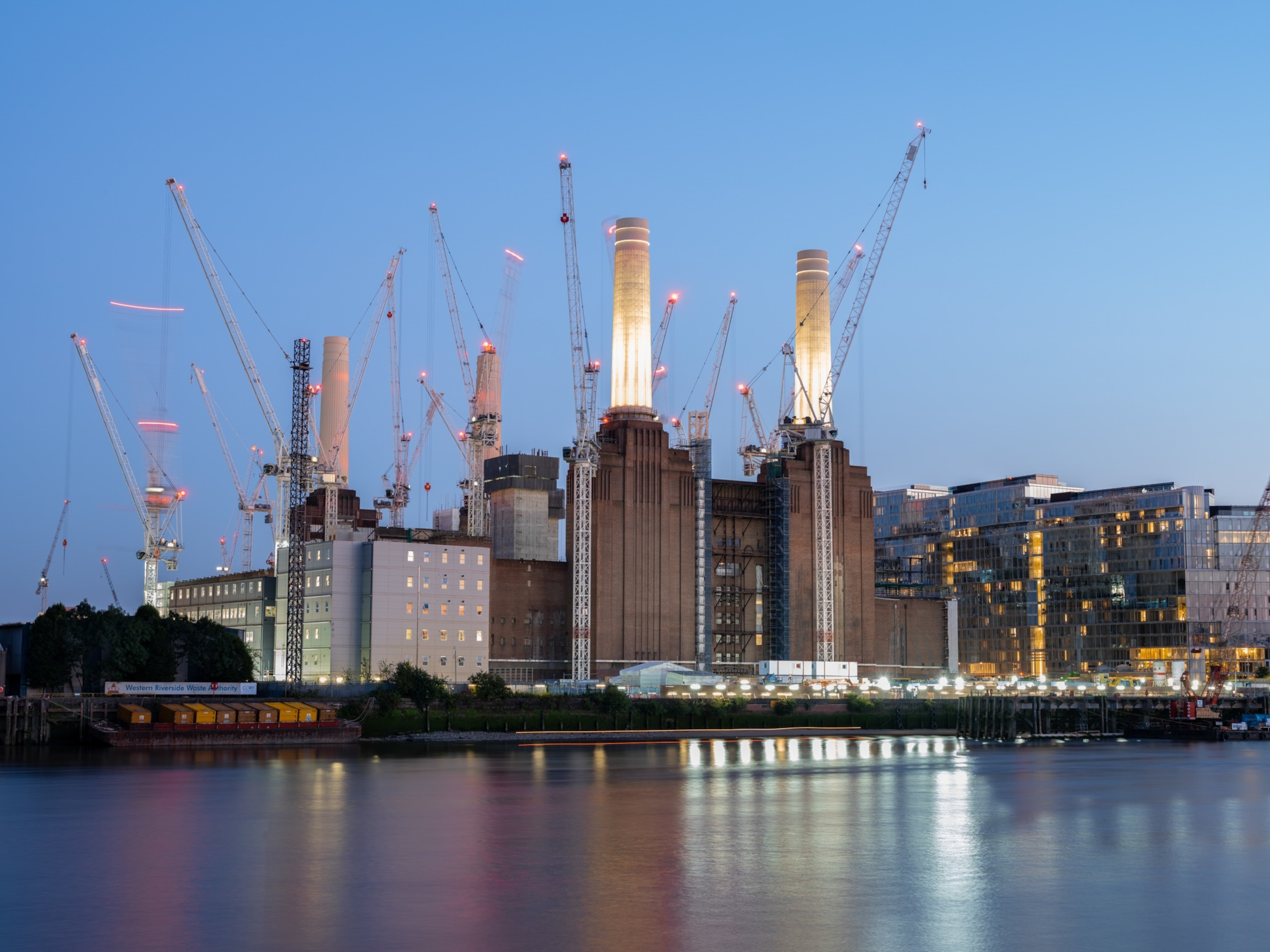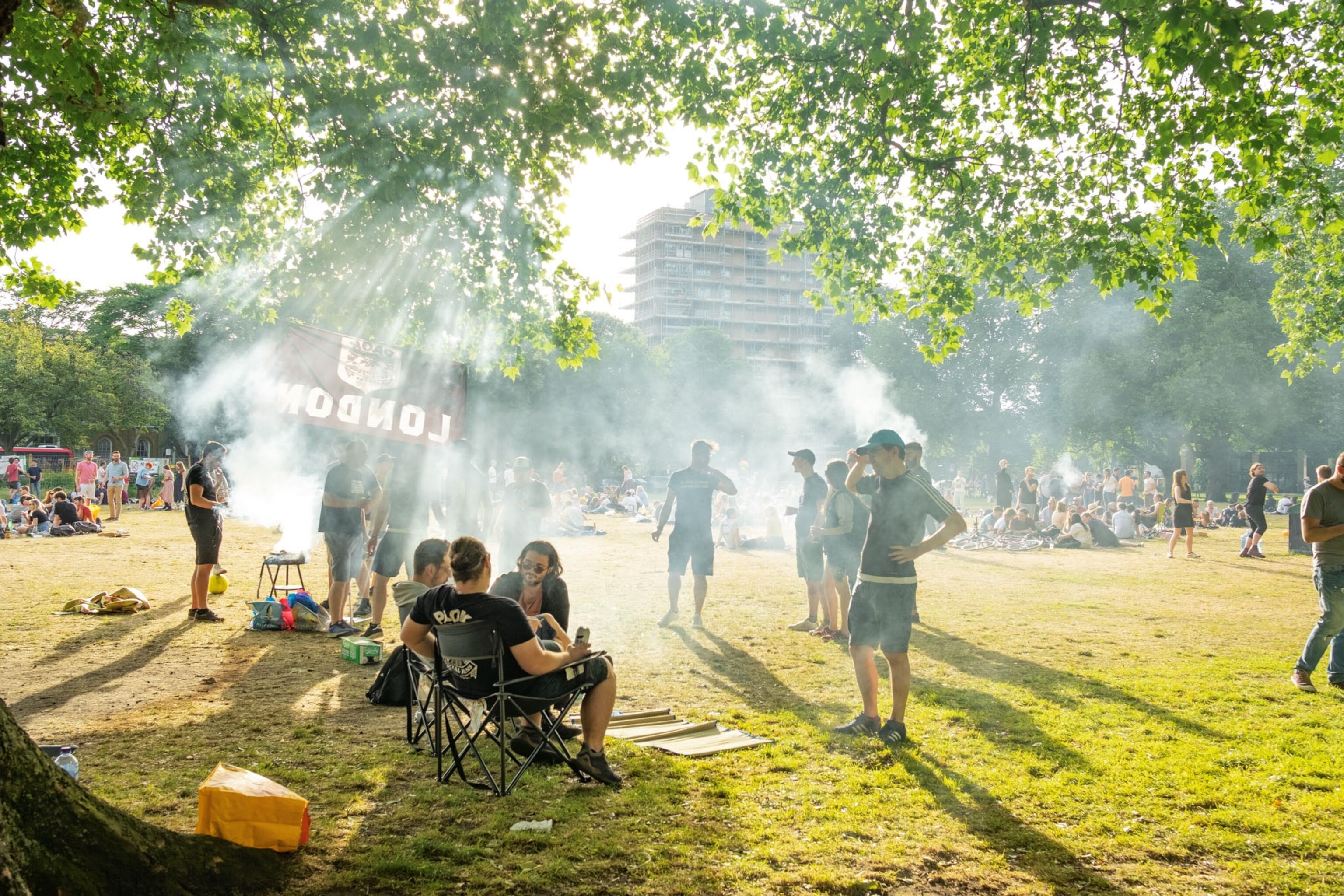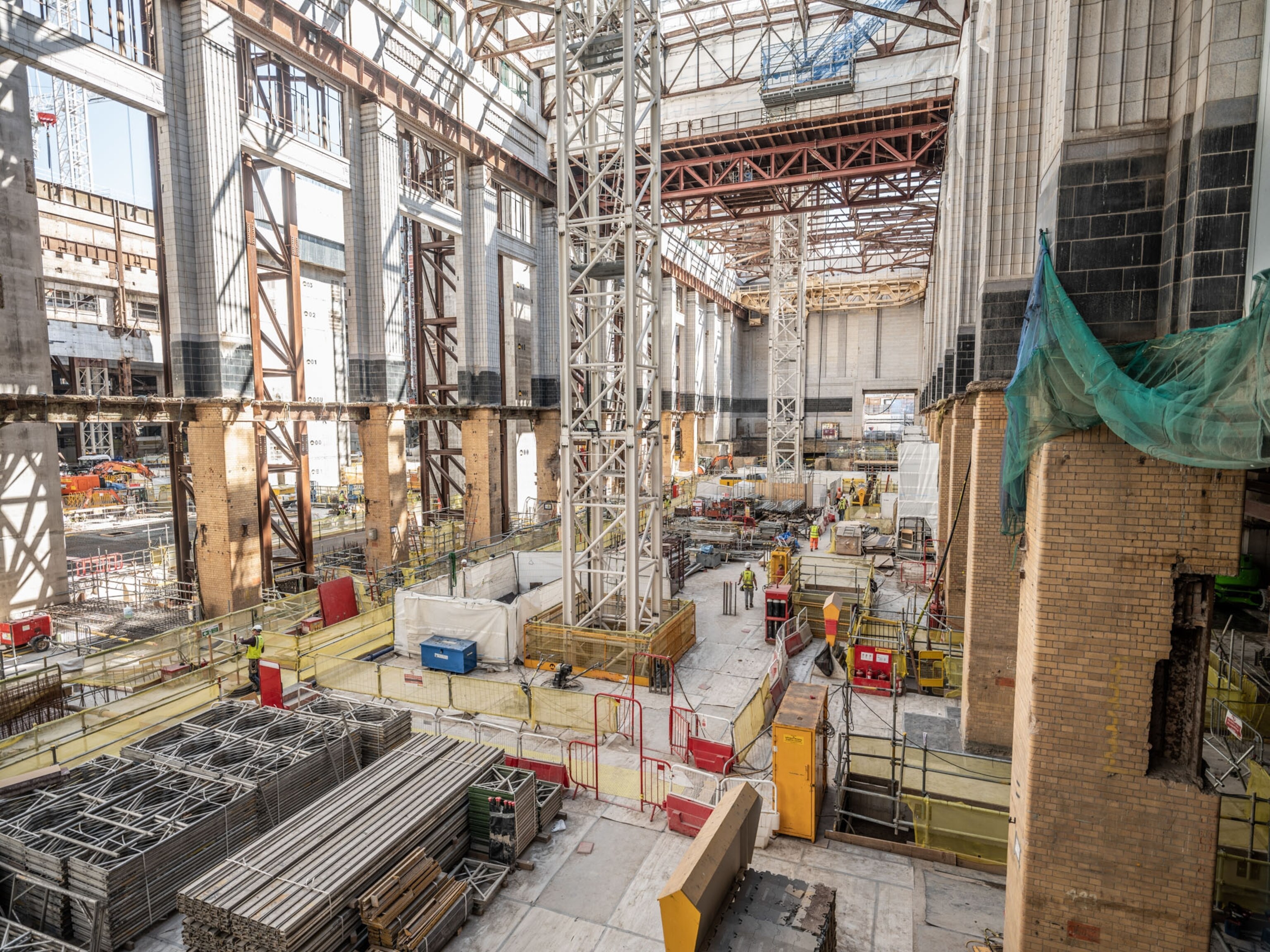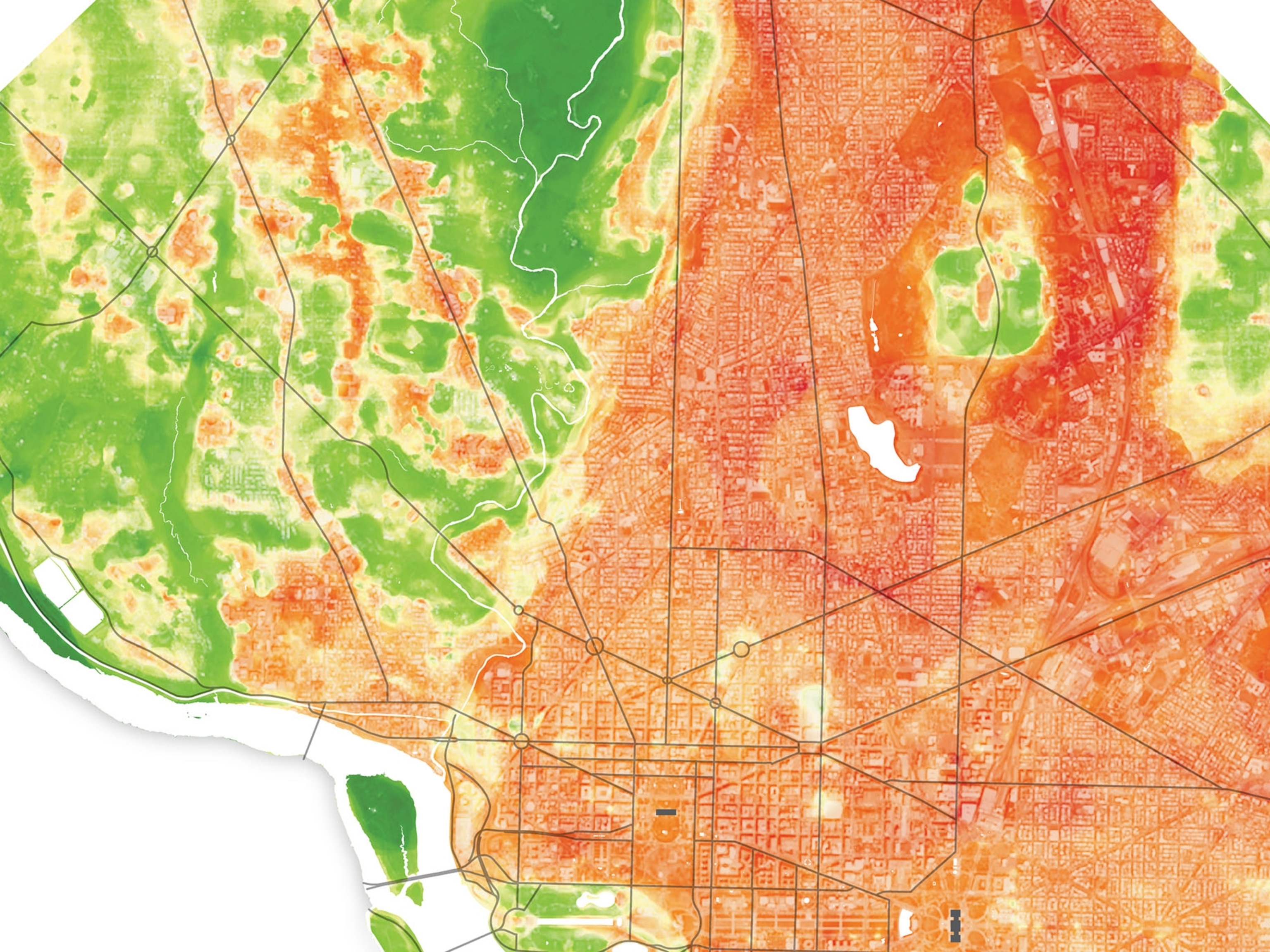
How London became the center of the world
Three decades of growth reinvented the urban landscape in London—and transformed it into the preeminent global city. But amid growing pains and with Brexit looming, can it stay on top?
The Royal Botanic Gardens at Kew lie in a curve of the Thames, seven miles upriver from central London.
It’s a pastoral respite from asphalt and exhaust, with thousands of plants collected from the British Empire’s far-flung reach. To stroll past beds of Himalayan rhododendrons and Tasmanian grasses is to also understand the sweep of Britain’s connectivity to the world beyond.

At Kew, though, one does not entirely escape the tumult of modern life. The gardens sit directly beneath the flight path into Heathrow. As I admired a massive, ancient oak, relocated from Iran during Queen Victoria’s reign, a stream of jets descended out of the holding queue aloft. Spaced 27 to 40 seconds apart—Kew arborists know the timing—they formed a line homing in on the busiest two-runway airport on the planet. At certain times of the day, “it’s just like bees around a honeypot,” says a commercial pilot who details Heathrow’s traffic jams in Craig Taylor’s oral history of modern London. “You’ll be flying back in across from France … and it’s all nice and relaxed … Then you hit the London frequency on the radio and suddenly everyone’s jabbering away. There’s a million and one voices on and the controller’s not got five seconds to take a breath … It’s busy, you’re gonna hold. Everyone wants to get into London.”
Bees to the honeypot: London is bigger and richer than ever. Three decades of growth transformed London from a fading grande dame into the preeminent global city and a leading center of culture, finance, and technology. The city is home to more than 8.8 million residents—a population expansion largely fed by immigration. And despite the upheaval of Brexit, London is on track to add two million more residents by 2050. All that growth fed a construction boom that is redrawing London’s historic skyline and includes several of the largest regeneration projects in Europe. More than 500 new tall buildings are in the pipeline across Greater London. Half are going up in East London, soon to be better connected to West London when Crossrail, the $20 billion high-speed railway, opens its Elizabeth line next year, relieving congestion on the aging London Tube and cutting travel times between east and west by as much as half.

Meanwhile, defunct industrial sites along the Thames and the city’s hundred-mile network of canals are being reinvented as new neighborhoods—and pricey waterfront real estate—featuring pedestrian-friendly public spaces and retail shops that favor local entrepreneurs over chain outlets. King’s Cross, a derelict railroad transfer point known more recently for prostitution and drugs, is showing Londoners what a well-rounded makeover looks like. The transformation includes the renewed King’s Cross and St. Pancras rail stations (the latter home to the Eurostar train to Paris), a new campus for an art and design college, music venues, parks and fountains, and housing—both high-end and affordable. Google, Deep Mind (Google’s artificial intelligence research lab), and Facebook are building unconventional London headquarters there. Google’s 11-story “landscraper,” large enough to house about 7,000 employees, may be the most original design. It stretches for a thousand feet, parallel to the King’s Cross railway platforms, and boasts that its rooftop garden will grow “fields” of wildflowers and feature a running trail.


Across town, on the Thames’s south side, a long-bedeviled development is under way that will reclaim the Nine Elms district, once better known for the defunct Battersea Power Station than enticing riverfront views. Reborn upscale, and helped in part by the new U.S. Embassy seat that opened here last year, the project also is positioning itself to be the city’s food quarter, anchored by the New Covent Garden Market. The London headquarters of tech giant Apple will occupy six floors in the massive power plant’s rebuilt boiler room.

Not surprisingly, London’s run of prosperity arrived with the usual set of urban headaches, and as they have worsened, many wonder whether their great city is losing its allure. Traffic is terrible. Air pollution is so bad that two million Londoners are living with illegal levels of toxic air, according to London’s emissions inventory agency. Rising land values have pushed housing prices beyond the reach of average Londoners, forcing even well-paid professionals to pack up the kids and move out in search of affordable suburbs where a family can live.
But three years of uncertainty over Brexit have trumped every urban annoyance. The U.K.’s unresolved withdrawal from the European Union has embroiled the government in political chaos that cost Prime Minister Theresa May her job, stymied industry planning, and threatens to bring the boom to an end. “Anyone who says anything about Brexit, however expert, is as likely to be wrong as right,” says Simon Jenkins, former chairman of the National Trust and a veteran journalist and author. “Really, no one has a clue.”
The U.K. economy has slowed, though London continues to add jobs. Large manufacturers, including Airbus and Japanese automakers, have threatened to leave if Brexit gets inked. On the other hand, Unilever and HSBC, after threatening to decamp for the Continent, are staying put. The pound is down, but London remains a leading source for venture capital and the global destination of choice for company headquarters, a distinction it has held since 2003, according to an analysis by the Centre for London, a progressive think tank.

“Airbus and the Japanese automakers are single stories. The one thing Brexit hasn’t done so far is create this rats-leaving-the-sinking-ship type of departures,” says Richard Brown, the center’s research director. “But the mood here is exhaustion. People are saying that we should just get on and leave, and to hell with Europe. Or, alternatively, that we should call the whole thing off. It’s been a disaster.”
Will boom turn to bust? Can London take on its challenges and remain the world’s great trading city and an appealing place to live? The idea that London teeters on the edge of unraveling seems unimaginable, even, and maybe especially, at a time like this. Londoners like to talk about their city’s enduring resilience. They recite, predictably, London’s ability to carry on through plague, the Great Fire of 1666, and the blitz bombing raids during World War II—all reassuring evidence that London will prevail again in its European divorce. In the current crisis, London is helped by the fact that there is no obvious challenger. Paris, Dublin, Amsterdam, and Frankfurt all have financial services industries, but none has quite the range of assets or the historic strengths that have carried London through 2,000 years, starting with the mother tongue. English is the universal language. London’s trading connections, established when the empire ruled a quarter of the world, are embedded in its DNA and give London an edge, especially in Asia, over would-be European competitors.
“London is in a privileged position where it’s kind of untouchable,” says Peter Griffiths, a city strategist at ING Media, a communications group specializing in the built environment. “It’s so far ahead of other cities, it can get away with things that other cities can’t.”
London’s historic strength is surpassed only by its geography. It was the British, after all, who mapped global time zones after solving the mathematical mystery of longitude. London sits at the center of the world today because it placed itself there when it drew the prime meridian, where east meets west.

The previous peak for London’s population coincided with the eve of World War II, when the city counted 8.6 million residents. London had been the world’s most populous city for most of the industrial age, but the war left it in shambles. Londoners who hadn’t fled ahead of the blitz—which killed 43,000 civilians and obliterated more than 70,000 buildings—fled the chaos of reconstruction afterward. They resettled in garden cities that grew into the suburbs of today and hunkered down as their country slogged through nearly four decades of postwar recovery.
As the manufacturing industry splintered, the docks of what was once the world’s largest port fell victim to shipping modernization and closed. The death in 1965 of Winston Churchill, the great prime minister, marked the end of the fraying empire and, the Observer noted, “the last time that London would be the capital of the world.” Population, meanwhile, continued a downward slide. But by the time it bottomed out at 6.4 million at the dawn of the 1990s, London’s fortunes were again on the rise, spurred by the “Big Bang” on October 27, 1986: the day the financial services industry deregulated, enabling London to rival Tokyo and New York. A new financial district rose on the ruins of the West India Docks on the Isle of Dogs, a marshy nub that juts into the Thames. Canary Wharf, as the district is called, became London’s first modern large-scale regeneration project.
Immigrants and foreign investment flowed in, and growth became the story of London for the next 30 years. Today Canary Wharf employs more than 100,000 people, and London has become a magnet for young, bright professionals from every corner of the world—who’ve changed the face of the city. Nearly 40 percent of London residents were born outside of the United Kingdom, and 300 languages are spoken on its streets.
London is home to about 300,000 Indians, and well over 100,000 people each from Pakistan and Bangladesh. Hundreds of thousands moved to London as the European Union expanded, including about 177,000 Poles and 150,000 Romanians. Officially, 82,000 French live in the city, though other estimates go as high as 250,000. London officially surpassed its 1939 population peak when the city took note of the 8,615,246th arrival, in early 2015. The individual was never pinpointed, but it’s more likely the newcomer showed up in a maternity ward than a border station; immigration had also started a baby boom.
So far Brexit hasn’t slowed the pace of immigration, only changed the mix of who’s coming. Fewer migrate from EU member states, and more migrate from outside the EU, primarily South Asia, according to a Centre for London analysis.

For a bird’s-eye view of the city’s changing skyline, I went to the top of the 52-story Cheesegrater—Londoners are fond of nicknaming their skyscrapers—in the heart of the original financial district, also known as the City of London, with Peter Murray, an architect who heads New London Architecture, a design forum. We peer out at the pickle-shaped Gherkin (41 stories), the Walkie-Talkie (36 stories), and the Shard (95 stories), the dramatic sentinel that’s the U.K.’s tallest high-rise.
The Cheesegrater, formally named the Leadenhall Building, won its nickname for its angular, wedge-shaped top floors, a design feature that complies with London’s “protected view” regulations prohibiting obstructions of sight lines to historic landmarks. In this case the protected view allows pedestrians strolling along Fleet Street to see St. Paul’s Cathedral and its 365-foot dome, which towered over London for more than 200 years. When cities began building skyscrapers in the 1880s, London never swooned. Londoners don’t even call them that—the preferred term is “tall buildings,” meaning buildings of at least 20 stories. The Gherkin changed Londoners’ minds. It went up over community objections, replacing a historic building that had been damaged by an IRA bombing in 1992 and that many wanted rebuilt. Today it is as beloved and recognizable as Big Ben, and helped smooth the way for a cluster of skyscrapers. By 2020 the collection will include the Flower Tower, the Vase, and the Can of Ham.
As we watch an impressive number of cranes swivel across the cityscape, Murray points east: Of the new buildings going up in London, 257 are in East London. Only a few of the total will truly scrape the sky. The future, he says, will push development to the outer boroughs, clustered around rail and Tube stations, creating multiple centers where people can live and work and shop—and abandon the long commute into central London.
There isn’t careful plotting for London’s skyline, he says. Each borough, guided by voters, decides for itself what kind of development to approve. Bromley, farther from the city center and, Murray says, “the essence of suburban London,” has no skyscrapers. Tower Hamlets, less than half the size though more central, has many.

What we can’t see from our perch just beyond the horizon is the Green Belt, created in the 1930s to keep sprawl in check. At three times the size of the city it encircles, it eventually forced development to leapfrog over London, and now it feels to some like an ever tightening stranglehold around the city’s girth. It includes parkland, golf courses, farms, but also brownfield sites and derelict buildings. Only an estimated 9 percent is publicly accessible. Suggestions that the Green Belt is the solution to London’s housing problem are as plentiful as London rain. But most development is barred, and efforts to open it up to builders amount to political suicide.
Murray favors what he calls “sensible planning” around it. “But that doesn’t mean, let it rip,” he says.


Sadiq Khan, the son of Pakistani immigrants and the fifth of eight children, became London’s first Muslim mayor in 2016. The city’s growth by then was twice the rate of the rest of the U.K. In his mayoral campaign, Khan promised “a better London” in his rapidly changing city. Brexit passed a month later. While London voters overwhelmingly opposed leaving the EU, the vote in the rest of the U.K. reflected a backlash against immigration and resentment that prosperity had not spread to the rest of the country. London may not contend with the megacity level of growth in Asia and Africa: According to one analysis, Lagos, Nigeria, now takes in 70 new residents an hour to London’s nine. But that’s still about 70,000 annually—the growth that Khan’s London Plan anticipates through mid-century.
Khan attacked threats to London’s livability on all fronts. Climate change? Becoming “zero carbon” by 2050 means more bicycles, fewer cars, a ban on the sale of diesel-burning autos, and building up a fleet of electric buses. Public safety? Protecting children on their walks to school and female pedestrians at night. Khan even unveiled a plan to save London’s disappearing historic pubs, some of which had closed because of changing drinking habits and higher rents and taxes, and to fight childhood obesity by restricting fast food outlets. And Khan backed the designation of London, a city with 8.4 million trees and multiple large parks, as the world’s first National Park City. The brainchild of geographer and National Geographic Explorer Daniel Raven-Ellison, the idea is to encourage Londoners to better acquaint themselves with the city’s environment, which includes 15,000 species of wildlife and plants.

“One in seven children has not visited a green space in the past year,” Raven-Ellison says. “I am talking about a cultural shift and challenging people’s notions of what their relationship with nature should be like.”
But Khan’s most daunting task is housing. After he took office, he announced that London needs 66,000 new houses a year just to keep up with growth and pledged that half would be “genuinely affordable.” Khan then came up with more than six billion dollars in government funding to build 116,000 affordable homes by 2022. As he campaigns for reelection in 2020, he promises to push Parliament for rent control. Many admire his housing ambitions but point to mayoral limitations: The mayor sets strategic targets for the city, but the 33 municipal councils determine development within their respective borders.

“Despite plan upon plan upon plan to build more housing, the truth is the rate of construction is nowhere near keeping up with the growth of the population,” says Tony Travers, who directs government studies at the London School of Economics.
Jules Pipe, one of Khan’s 10 deputy mayors, says it’s essential to try. “If we exclude swaths of the public from being able to live and commute cheaply in the capital,” he says, “then the whole capital begins to fail on everything, from being kept clean to whether we have a shortage of doctors at the hospital.”

Central London is often viewed as an island for tourists and absentee Russian oligarchs and Saudi princes who spend just a few weeks a year at their multimillion-dollar properties. Jenkins, the former National Trust chairman, sees London as becoming more of an investment market than a place where people actually live.
“They want to put their money into it and leave it, as if the city had become a bank,” he says. “These towers of luxury apartments are simply blocks of gold.”
Trevor Abrahmsohn, a real estate agent to the rich, says one of the side effects of being a global city is that it attracts wealth. The Qatari royal family owns more real estate in London than the British royal family, with a portfolio of quintessentially British icons that includes Harrods and Claridge’s, most of the Shard, the former U.S. Embassy in Grosvenor Square (which will reopen as a luxury hotel), 20 percent of Heathrow Airport, and a portion of Canary Wharf.

“When the Shah of Iran was ousted, his first port of call was London,” he says. “When the Nigerians made money in oil, they bought in London. When the Indians made money on the Nigerians, they bought in London. When the Berlin Wall fell, the Russians bought, and now it’s the Chinese.”
The Nine Elms project, which stretches over 500 acres along the Thames, is seen, fairly or unfairly, as a place filled with those stacks of bank accounts. It earned the name Dubai-on-Thames after the first round of apartments were sold mainly to foreign buyers, and advertises, among its many sumptuous amenities, the world’s first “sky pool,” which bridges the rooftops of twin buildings of luxury flats.
But the project also illuminates why Khan’s housing targets may be so hard to reach. The power plant, one of the world’s largest brick buildings, has long been an iconic landmark on the skyline. “An industrial St. Paul’s,” Jenkins says, and possibly large enough to fit St. Paul’s inside. Pink Floyd featured the plant on an album cover, and several blockbuster films have used it as a backdrop.

The plant closed in 1983. But fame also saved it from—or prevented, if you prefer—demolition, locking in the huge cost of refurbishing it. Multiple developers came and went. In 2012 a Malaysian consortium took over the nearly $12 billion project, which includes remaking the plant into commercial and residential space and restoring its four chimneys. The developers also contributed nearly $400 million to the $1.3 billion construction of two new Tube stations, improving access to the area. The investment won them a reduction in the number of affordable housing units that had been slated.
Ravi Govindia, leader of the Wandsworth borough council, which approved the project, says the infrastructure and restoration more than compensated. “Every development has a finite contribution it can give to the improvement of public services,” he says. “Affordable housing is one component.”
The development also will contain two riverside piers, two primary schools, two health centers, improved bicycle paths, and Linear Park, which is styled after New York’s High Line and runs like a “green spine” through the entire district.
“The greatest challenge in any urban setting is how do you renew an area and provide the things that make urban living bearable and desirable?” he asks. “You can’t do that by doing a lot of one thing. You need to do lots of bits of things.”

Opportunity is also found at the site of the 2012 Olympics. It’s been converted to a much-used Queen Elizabeth Olympic Park, with the swimming pool complex, the velodrome, and the stadium. The athlete’s village, where 17,000 competitors slept, was refashioned into nearly 3,000 apartments. Half of the units rent for market rate, half qualify as affordable, many with enough bedrooms to hold a family.
Last year Khan outlined a $1.4 billion expansion that includes more housing, a dance theater, new campuses for both the London College of Fashion and University College London, and a branch of the Victoria and Albert Museum.
In the run-up to the games, then Mayor Ken Livingstone emphasized the event’s potential to jump-start a regeneration of neglected, impoverished parts of East London. Ricky Burdett, head of the London School of Economics’ cities program and a top adviser for the games, says the pieces are in place for a multidecade renewal project, like King’s Cross.

“When we first looked the site over,” he recalls, “we said we must be nuts. There were tires burning in the center, where the Olympic stadium was built.” One of the first chores was to connect the site to the surrounding area by building some 30 bridges, viaducts, walking paths, and bicycle lanes. “None of this would have been built if it were not for the games,” he says. “But this is a 35-year project.”
Our tour ends near Tower Hamlets, a borough that may most represent London’s changes and contradictions. It’s tiny, encompassing only eight square miles, much of it former industrial dockland. But it is London’s fastest growing borough, with an estimated 308,000 people, containing some of the city’s poorest enclaves, and some of the richest.
The borough has been a beachhead for newly arrived immigrants for three centuries. A landmark building encapsulates those layers of history: It was a meetinghouse for French Huguenots during the 18th century, then a synagogue for Jews fleeing Eastern Europe, and today it’s a mosque. The nearby streets have been dubbed Banga Town, in celebration of the Bangladeshis, now Tower Hamlets’ largest immigrant group.

The borough also takes in Canary Wharf, the third largest contributor to the U.K. economy. Among the tall buildings going up across London, 84 are being built in Tower Hamlets, more than any other borough. Many are part of an expansion to transform Canary Wharf into a livable community instead of just a workplace. It’s where uncertainty about Brexit’s effect on the thriving financial services industry is most keenly felt. Some construction has paused. Some banking jobs have shifted to Paris or Frankfurt. Last summer, worried borough leaders set up a Brexit commission to deal with the consequences should jobs disappear and immigration limits be set.
If the U.K. leaves the European Union, it will be the first time in centuries that London will be standing alone in the world. “England went from being an imperial power with a long history as a trading empire, and then afterwards as a principal city within the EU,” Brown says. “The transition to this new status, whether as an unleashed global city or something less powerful, is quite dramatic.”
And yet, despite Brexit anxieties, optimism about this ancient trading city persists. One of Canary Wharf’s newest additions, the station for the new Elizabeth line, is a rail station for the ages: seven stories high and loaded with retail, shops, cafés, a movie theater, and a gym. If you pass through, take time to go all the way up to the roof. There, a garden that celebrates London’s place in history and geography stretches for nearly a thousand feet, with east and west “hemispheres” neatly planted with flora native to countries visited by the ships of the West India Docks. I paused in the center, at the dividing line where the hemispheres meet. We’re just a short boat ride from Greenwich, where the real prime meridian line–longitude zero–is painted on the pavement outside the Royal Observatory. A replica is drawn here, between the bamboo in the east and the ferns in the west, and serves as a reminder: No matter what else befalls it, London remains at the center of the world.

This story was updated to reflect how it appeared in the August 2019 issue of National Geographic magazine.
Related Topics
Go Further
Animals
- Soy, skim … spider. Are any of these technically milk?Soy, skim … spider. Are any of these technically milk?
- This pristine piece of the Amazon shows nature’s resilienceThis pristine piece of the Amazon shows nature’s resilience
- Octopuses have a lot of secrets. Can you guess 8 of them?
- Animals
- Feature
Octopuses have a lot of secrets. Can you guess 8 of them? - This biologist and her rescue dog help protect bears in the AndesThis biologist and her rescue dog help protect bears in the Andes
Environment
- This pristine piece of the Amazon shows nature’s resilienceThis pristine piece of the Amazon shows nature’s resilience
- Listen to 30 years of climate change transformed into haunting musicListen to 30 years of climate change transformed into haunting music
- This ancient society tried to stop El Niño—with child sacrificeThis ancient society tried to stop El Niño—with child sacrifice
- U.S. plans to clean its drinking water. What does that mean?U.S. plans to clean its drinking water. What does that mean?
History & Culture
- Gambling is everywhere now. When is that a problem?Gambling is everywhere now. When is that a problem?
- Beauty is pain—at least it was in 17th-century SpainBeauty is pain—at least it was in 17th-century Spain
- The real spies who inspired ‘The Ministry of Ungentlemanly Warfare’The real spies who inspired ‘The Ministry of Ungentlemanly Warfare’
- Heard of Zoroastrianism? The religion still has fervent followersHeard of Zoroastrianism? The religion still has fervent followers
- Strange clues in a Maya temple reveal a fiery political dramaStrange clues in a Maya temple reveal a fiery political drama
Science
- Soy, skim … spider. Are any of these technically milk?Soy, skim … spider. Are any of these technically milk?
- Can aspirin help protect against colorectal cancers?Can aspirin help protect against colorectal cancers?
- The unexpected health benefits of Ozempic and MounjaroThe unexpected health benefits of Ozempic and Mounjaro
- Do you have an inner monologue? Here’s what it reveals about you.Do you have an inner monologue? Here’s what it reveals about you.
- Jupiter’s volcanic moon Io has been erupting for billions of yearsJupiter’s volcanic moon Io has been erupting for billions of years
Travel
- Follow in the footsteps of Robin Hood in Sherwood ForestFollow in the footsteps of Robin Hood in Sherwood Forest
- This chef is taking Indian cuisine in a bold new directionThis chef is taking Indian cuisine in a bold new direction
- On the path of Latin America's greatest wildlife migrationOn the path of Latin America's greatest wildlife migration
- Everything you need to know about Everglades National ParkEverything you need to know about Everglades National Park



